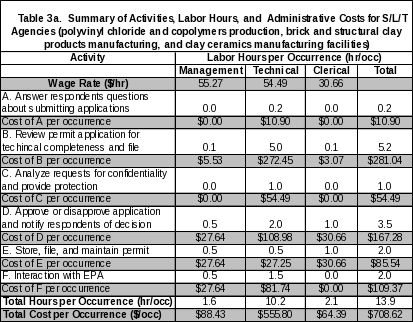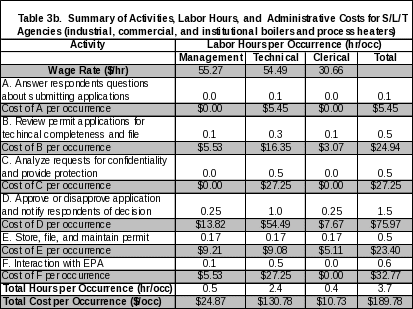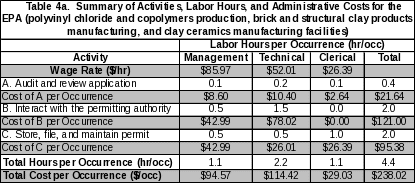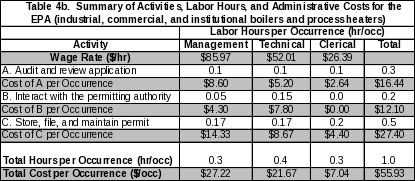1648ss07
1648ss07.doc
Requirements for Control Technology Determinations from Major Sources in Accordance with Clean Air Act Section 112(j) (Proposed Rule)
OMB: 2060-0266
Information Collection Request for Requirements for Control Technology Determinations from Major Sources in Accordance with Clean Air Act Section 112(j)
Supporting Statement
PART A OF THE SUPPORTING STATEMENT
1. IDENTIFICATION OF THE INFORMATION COLLECTION
(a) Title and Number of the Information Collection
ICR: Requirements for Control Technology Determinations from Major Sources in Accordance with Clean Air Act Section 112(j).
OMB Control Number: 2060-0266, EPA ICR # 1648.07.
(b) Short Characterization
Section 112 of the Clean Air Act (CAA) requires EPA to establish National Emissions Standards for Hazardous Air Pollutants (NESHAP) for both major and area sources of hazardous air pollutants (HAP) that are listed for regulation under CAA section 112(c). An area sources is a stationary source that is not a major source (i.e., an area source does not emit and does not have the potential to emit more than 10 tons per year [tpy] of any single HAP and more than 25 tpy of any combination of HAP). Section 112(j) of the CAA requires that if EPA fails to promulgate a standard for a category or subcategory of major sources within 18 months after its scheduled date of promulgation, then sources must submit a title V permit application beginning on that date. States (with approved title V operating permit programs) or EPA will issue permits containing maximum achievable control technology (MACT) emission limitations determined on a case-by-case basis to be equivalent to what would have been promulgated by EPA pursuant to CAA section 112(d).
EPA has promulgated regulations implementing section 112(j) for all of the listed categories and the previous OMB clearance for the section 112(j) regulation was allowed to lapse. However, recent vacaturs of several MACT standards (Polyvinyl Chloride and Copolymers Production (“PVC”), Brick and Structural Clay Products Manufacturing ("Brick"), Clay Ceramics Manufacturing (“Clay Ceramics”), and the Industrial, Commercial and Institutional Boilers and Process Heaters (“Boilers”)) have re-established the need for applying the rule implementing section 112(j) of the CAA. EPA is proposing revisions to the section 112(j) rule to clarify the application of section 112(j) in the case of complete standards vacaturs and to clarify and streamline the permit application and review process for the vacatur situation. The purpose of this ICR is to reinstate the OMB clearance for the revised section 112(j) regulation.
This ICR supports the regulation to implement section 112(j) (40 CFR part 63, subpart B, §§63.50-56). It addresses the information collection burden (hours and costs) to industry respondents subject to these provisions; State and Local agencies that review applications submitted under these provisions; and the EPA oversight review of a percentage of State/Local decisions. As discussed further below, only activities related to the regulatory requirement to submit permit applications are activities for which an estimate of burden need be calculated.
This ICR includes about 149 major sources and 15,500 boilers at major sources (see Table 1) contained in the four source categories for which MACT standards have been vacated by the United States Court of Appeals for the District of Columbia Circuit. The average administrative cost per major source of these activities is estimated to be $3,148, and the average administrative cost per boiler of these activities is estimated to be $1,048. Total estimated administrative costs may be up to $19,766,560 for all sources in all four source categories over the next 3 years.
Further, the burden estimate is conservative, because we assume 15,500 boilers are subject to section 112 and therefore covered by this ICR, based on the number of initial notifications received following promulgation of the boiler MACT. However, this assumption likely represents an overestimate of the number of such sources. EPA's major source boiler MACT was vacated by the DC Circuit Court of Appeals, along with a separate rule defining a “commercial or industrial solid waste incineration unit” for purposes of Section 129 of the Act (the definitional rule). NRDC V. EPA, 489 F.3d. 1250 (D.C. Cir. 2007). In the definitional rule case, the court held that Section 129’s directive to regulate “any facility which combusts any solid waste material from commercial or industrial establishments” does not permit the exclusion of facilities that combust solid waste, but recover thermal energy for a useful purpose The court then concluded that the flaws in EPA’s definitional rule would necessitate revision of the major source boiler MACT rule as well, because the scope of facilities subject to the MACT would change. Therefore the court also vacated the boiler MACT. Once EPA revises both the definitional rule and the boiler MACT, it is likely that the number of sources subject to the boiler MACT will be smaller than those that would have been subject to the MACT the court vacated.
2. NEED FOR AND USE OF THE COLLECTION
(a) Need/Authority for the Collection
Section 112(j) of the Clean Air Act as amended in 1990 contains the need and authority for this information collection. [42 U.S.C. 7401 (et. seq.) as amended by Public Law 101-549]
(b) Use/Users of the Data
The information collected in the permit applications will be used for the purposes of permit approval, compliance determination, and the selection of particular control technology on a case-by-case basis. The Federal or State administrator of the operating permits program will use the information for the case-by-case emission limit determinations. Because the information gathered is necessarily source-specific, the case-by-case determinations cannot be made without it.
3. NONDUPLICATION, CONSULTATIONS, AND OTHER COLLECTION CRITERIA
3(a) Nonduplication
The information collection activities required under the section 112(j) regulation are not routinely collected elsewhere by EPA. However, in this situation, the permitting authority may likely have collected much, if not all, of the information items previously in support of other applications in the course of implementing or preparing to implement the MACT standards that have been vacated. Most permitting authorities, though, will likely accept references to previously submitted information in lieu of significant duplication, in accordance with §63.53(b)(1).
3(b) Public Notice Required Prior to ICR Submission to OMB
Since this is a reinstatement of a previously approved ICR, it will be treated as if it were a new collection. Comments will be solicited on the proposal amendments to the section 112(j) rule and this ICR.
3(c) Consultations
Several industry representatives commented on a previous version of the ICR (#1648.06), the availability of which was announced in the Federal Register on April 17, 2008 (73 Federal Register 20920). The relevant comments that were reviewed have been considered in this ICR (#1648.07). These commenters were Pillsbury, Winthrop Shaw, Pittman representing the American Forest & Paper Association, the American Petroleum Institute, the National Oilseed Processors Association, and the Synthetic Organic Chemical Manufacturers Association; the Alliance of Automobile Manufacturers; the Council of Industrial Boiler Owners; the National Association of Clean Air Agencies; the Brick Industry Association; the Vinyl Institute; and the Occidental Chemical Corporation (see Docket No. EPA-HQ-OAR-2002-0038).
3(d) Effects of Less Frequent Collection
Each applicant would submit the required information only once (a permit application) over the term of this ICR. There is no less frequent collection.
3(e) General Guidelines
The recordkeeping and reporting requirements contained in the section 112(j) regulation do not violate any of the Paperwork Reduction Act guidelines contained in 5 CFR 1320.6.
3(f) Confidentiality
Any information submitted to a permitting authority with a claim of confidentiality will be safeguarded according to that agency’s policies set forth prior to approval of the agency’s operating permit program by EPA. Any confidential information submitted to EPA will be safeguarded according to policies in 40 CFR, Chapter 1, Part 2, Subpart B -- Confidentiality of Business Information.
3(g) Sensitive Questions
This section is not applicable. This ICR does not contain any sensitive questions relating to sexual behavior or attitudes, religious beliefs, or other matters usually considered private.
4. THE RESPONDENTS AND THE INFORMATION REQUESTED
4(a) Respondents/NAICS Codes
Respondents include owners/operators of major sources of HAP in the following source categories: polyvinyl chloride and copolymers production, brick and structural clay products manufacturing, clay ceramics manufacturing, and industrial, commercial, and institutional boilers and process heaters (Table 1). A major source is one that has the potential to emit considering controls, in the aggregate, 10 tons per year or more of any HAP or 25 tons per year or more of any combination of HAP. The boilers source category cuts across a wide variety of industries, including both manufacturing and nonmanufacturing sources. The North American Industry Classification System (NAICS) codes for polyvinyl chloride and copolymers production, brick and structural clay products manufacturing, and clay ceramics manufacturing facilities are 325211, 327121, 327122, and 327123; and the three-digit NAICS codes for industrial, commercial, and institutional boilers and process heaters are 211, 221, 316, 321, 322, 324, 325, 326, 331, 332, 336, 339, 611 and 622.
4(b) Information Requested
(i) Data items, including recordkeeping requirements
Section 112(j) regulation does not contain recordkeeping requirements. However, we have included an estimate for burden associated with filing the permit applications and permits.
The section 112(j) regulation requires a title V permit application or revision. State and local agencies that develop the permit will review the information provided in the permit applications. EPA will provide oversight to the process.
The permit application for a MACT determination requires the following information:
(1) The name and address (physical location) of the major source.
(2) A brief description of the major source and an identification of the relevant source category.
(3) An identification of the types of emission points belonging to the relevant source category.
(4) An identification of any affected sources for which a section 112(g) MACT determination has been made.
(5) For a new affected source, the anticipated date of startup of operation.
(6) Each emission point or group of emission points at the affected source which is part of a category or subcategory for which a permit application is required, and each of the hazardous air pollutants emitted at those emission points. When the Administrator has proposed a standard pursuant to section 112(d) of the Act for a category or subcategory, such information may be limited to those emission points and hazardous air pollutants which would be subject to control under the proposed standard.
(7) Any existing Federal, State, or local limitations or requirements governing emissions of hazardous air pollutants from those emission points which are part of a category or subcategory for which a permit application is required.
(8) For each identified emission point or group of affected emission points, an identification of control technology in place.
(9) Any additional emission data or other information specifically requested by the permitting authority.
For many sources the permitting authority already has much of this information, gathered through previous title V permit submittals. A source may work with its permitting authority to determine what additional or revised information is necessary for a complete application submittal.
(ii) Respondent Activities
Activities (see Tables 2a and 2b) that the owner or operator must perform include:
- Develop and submit permit applications
- File and maintain the permit applications
- Utilize legal and consulting resources, as desired
- File and maintain permit.
5. THE INFORMATION COLLECTED -- AGENCY ACTIVITIES, COLLECTION METHODOLOGY, AND INFORMATION MANAGEMENT
5(a) Agency Activities
This section addresses the activities of State and Local agencies, as the permitting authority, and EPA, in an oversight capacity. The permitting authority, typically the State or Local air agency, will perform the following activities (see Tables 3a and 3b):
- Review permit applications and deny or approve them
- File and maintain permit applications
- Interact with EPA as appropriate
- File and maintain permit.
Acting in an oversight capacity, EPA will perform the following activities (see Tables 4a and 4b):
- Review permit applications
- Interact with the permitting authority
- File and maintain permit.
5(b) Collection Methodology and Management
The owners or operators of the sources affected by this regulation will have the responsibility of submitting permit applications to the permitting authority. It is the responsibility of the permitting authority to provide information necessary for EPA oversight review.
Qualified staff who work for the permitting authority will perform the permit application reviews and check the quality of data submitted by the applicant on a case-by-case basis. The permitting authority’s employees will handle confidential information submitted by the applicant according to the permitting authority’s confidential information handling procedures.
The section 112(j) regulation does not require the request of information through any type of survey.
5(c) Small Entity Flexibility
Minimizing the information collection burden for all sizes of organizations is a continuing effort on EPA’s part. EPA has reduced the information required by requiring only basic information needed by the permitting authority to make a case-by-case MACT determination.
5(d) Collection Schedule
This ICR does not require surveys. Each source affected by the section 112(j) regulation is required to submit a permit application which the permitting authority must then review.
6. ESTIMATING THE BURDEN AND COST OF THE COLLECTION
6(a) Estimating Respondent Burden
This ICR requires the calculation of the amount of burden hours associated with each activity for each respondent. In the section 112(j) permitting process for major sources, each respondent must submit the permit application as specified in section 4(b)(i) of this Supporting Statement. Much of the information required in the permit application will have already been submitted to the permitting authority in previous permit submittals; we expect the burden to be relatively low for this activity.
For the section 112(j) regulation, burden for the respondents is administrative costs (preparing and submitting the permit applications).
We estimate the burden associated with the preparation and submittal of permit applications to be about 35 hours for polyvinyl chloride and copolymers production, brick and structural clay products manufacturing, and clay ceramics manufacturing facilities (see Table 2a); and about 11 hours for each industrial, commercial, and institutional boiler and process heater (see Table 2b).
We have separated the burden estimates for boilers from the other sources. Unlike the other sources, boilers consist of a single emission point and many facilities contain essentially identical boilers, making permit application preparation for each boiler much less burdensome than preparing a permit application for the other sources, which consist of various different emission points.
6(b) Estimating Respondent Costs
(i) Estimating Labor Costs
Wage rates were based on May 2008 raw labor rates for the Manufacturing Sector (NAICS 31 thru 33), loaded using an overhead factor of 110%, and indexed to June 2009 using the Employment Cost Index. The resulting rates are $121.08 for management personnel, $82.39 for technical personnel, and $31.41 for clerical personnel. These values were taken from the Bureau of Labor Statistics Occupational Employment Statistics Survey Web site (http://www.bls.gov/oes/2008/may/naics2_31-33.htm) and reflect the latest values available (May 2008). The Employment Cost Index is located at: http://www.bls.gov/news.release/eci.t02.htm. Tables 2 and 2a provide a breakdown of labor hours and associated costs per occurrence for each activity in each part of the application process for existing and new sources.
(ii) Estimating Capital and Operation and Maintenance (O&M) Costs
We do not expect sources to expend additional capital and O&M costs to gather information required by the permit applications.
(iii) Annualizing Capital Costs
Not applicable.
6(c) Estimating State/Local Agency Burden and Cost
Similar to sections 6(a) and 6(b), the activities for State/Local agencies are divided into the activities that would take place for the application process as described in section 4(b)(i) of this Supporting Statement. Wage rates for State/Local employees were retrieved from the Bureau of Labor Statistics (http://www.bls.gov/news.release/pdf/ecec.pdf, “Table 4. Employer costs per hour worked for employee compensation and costs as a percent of total compensation: State and local government workers, by occupational and industry group, June 2009”) and are as follows: $33.02 per hour for management labor, $32.64 per hour for technical labor, and $16.80 per hour for clerical labor. We added in the value of total benefits in BLS Table 4. We chose 20 percent of the base rate as the percentage of salary that constitutes overhead. The addition of benefits and overhead to the hourly rate produces a pay rate that reflects the true cost to employ a State, Local, or Tribal agency worker. Following is a summary of the computed hourly wages for State, Local, and Tribal agency employees.
Hourly Labor Rates for State, Local and Tribal Respondents |
||||
Labor Type |
Hourly Rate |
Benefits
|
Overhead (20 % Salary) |
Adjusted Hourly Rate |
Management |
$33.02 |
$15.65 |
$6.60 |
$55.27 |
Technical |
$32.64 |
$15.32 |
$6.53 |
$54.49 |
Clerical |
$16.80 |
$10.50 |
$3.36 |
$30.66 |
Tables 3a and 3b provide a breakdown of labor hours and associated costs for State/Local/Tribal agencies.
There are a total of 112 State/Local agencies that have a Title V permitting program, and one-third (37) of these State/Local agencies would review the section 112(j) applications in any given year.
6(d) Estimating Agency Burden and Cost
Under the section 112(j) regulation, EPA would serve in an oversight capacity and audit approximately 10 percent of all applications processed by State/Local agencies. Wage rates for EPA employees are based upon the Federal government pay scale. We calculated the hourly rates for EPA employees using information on annual salaries from the Internet site for the Office of Personnel Management. (http://www.opm.gov/oca/09tables/pdf/RUS.pdf; January 2009). We used the appropriate pay grade levels for management, technical, and clerical personnel. We divided the annual pay rate by 2080, the amount of working hours during a calendar year, to get the hourly wage rate. We then multiplied this rate by 1.6 to produce a pay rate that reflects the true cost to the Federal government to employ a worker. The value of 1.6 incorporates the addition of benefits at 40 % of salary and the addition of overhead at 20% of salary to the hourly rate. Following is a summary of the computed wages for EPA personnel.
Hourly Labor Rates for EPA |
||||||
Labor Type |
Pay Grade |
Annual Salary |
Hourly Rate |
Benefits (40 % Salary) |
Overhead (20 % Salary) |
Adjusted Hourly Rate |
Management |
GS-15 |
$111,760 |
$53.73 |
$21.49 |
$10.75 |
$85.97 |
Technical |
GS-12 |
$67,613 |
$32.51 |
$13.00 |
$6.50 |
$52.01 |
Clerical |
GS-6 |
$34,300 |
$16.49 |
$6.60 |
$3.30 |
$26.39 |
Tables 4a and 4b provide a breakdown in the amount of hours associated with each activity and the total burden hours and cost per occurrence.
6(e) Estimating the Respondent Universe
The estimated number of major sources subject to the section 112(j) regulation in the proposed ICR is based on latest estimates from the EPA rule writers for each of the affect source categories.
After the vacatur of the boiler NESHAP, the Agency began collecting data from EPA regional offices and delegated state authorities to revise its estimate of boilers and process heaters that may be impacted under a revised standard. Since the last boiler and process heater data gathering effort, many sources have shut down, others have selected to operate with a limit on their HAP emissions in order to avoid being subject to the boiler and process heater NESHAP, and some units have switched out older solid fuel units for newer equipment due to increased insurance and maintenance costs. Therefore, the Agency will base its boiler respondent pool on a revised list of initial notifications, Title V permits, and state applicability lists. Since the proposal of this ICR, data from Alaska, Alabama, Colorado, Delaware, Florida, Georgia, Indiana, Illinois, Kentucky, Louisiana, Michigan, New Jersey, New York, North Carolina, Ohio, Tennessee, Utah, and Wisconsin has been compiled and reviewed, and the Agency estimates that 15,500 existing boilers will be subject to this ICR. The estimated number of potentially affected sources is shown in Table 1.
6(f) Bottom Line Burden Hours and Cost
(i) Respondent tally
Over the 3-year period of this ICR, the estimated average annual respondent burden and cost associated with the section 112(j) regulation are 83,670 hours and $6,588,853 respectively. Table 5 contain the total estimated burden and cost breakdown associated with the section 112(j) regulation. Table 6 provide a summary of the estimated bottom line burden hours and costs associated with the section 112(j) regulation.
(ii) The Agency tally
Over the 3-year period of this ICR, the average annual Federal Government cost is $30,079 for 539 hours for the section 112(j) regulation. The bottom line Agency burden hours and costs presented in Table 5.
(iii) Variations in the annual bottom line
This section does not apply since no significant variation is anticipated.
6(g) Reasons for Change in Burden
We are requesting an increase in burden of 83,670 hours due to reinstatement of the previously approved collection.
6(h) Burden Statement
This estimate includes all activities associated with the respondents or government agencies. Overall, the section 112(j) program will have the following average annual burden: 63,863 hours and $5,573,129 for respondents; 19,807 hours and $1,015,725 for State/Local/Tribal agencies; and 539 hours and $30,079 for the EPA. Table 5 presents the annual burden for respondents, State/Local agencies, and the EPA over the next 3 years.
Burden means the total time, effort, or financial resources expended by persons to generate, maintain, retain, or disclose or provide information to or for a Federal agency. This includes the time needed to review instructions; develop, acquire, install, and utilize technology and systems for the purposes of collecting, validating, and verifying information, processing and maintaining information, and disclosing and providing information; adjust the existing ways to comply with any previously applicable instructions and requirements; train personnel to be able to respond to a collection of information; search data sources; complete and review the collection of information; and transmit or otherwise disclose the information.
An agency may not conduct or sponsor, and a person is not required to respond to a collection of information unless it displays a currently valid OMB control number. The OMB control numbers for EPA’s regulations in 40 CFR part 63 are listed in 40 CFR part 9.
To comment on the Agency’s need for this information the accuracy of the provided burden estimates, and any suggestions for minimizing respondent burden, including through the use of automated collection techniques, EPA has established a public docket for this ICR under Docket ID No. EPA-HQ-OAR-2009-0746, which is available for online viewing at http://www.regulations.gov, or in person viewing at the Air and Radiation Docket and Information Center in the EPA Docket Center (EPA/DC), EPA West, Room 3334, 1301 Constitution Ave., NW, Washington, DC. The EPA Docket Center Public Reading Room is open from 8:30 a.m. to 4:30 p.m., Monday through Friday, excluding legal holidays. The telephone number for the Reading Room is (202) 566-1744, and the telephone number for the Air Docket is (202) 566-1742. An electronic version of the public docket is available at http://www.regulations.gov. This site can be used to submit or view public comments, access the index listing of the contents of the public docket, and to access those documents in the public docket that are available electronically. When in the system, select “search,” then key in one of the Docket ID Numbers identified above. Also, you can send comments to the Office of Information and Regulatory Affairs, Office of Management and Budget, 725 17th Street, NW, Washington, DC 20503, Attention Desk Officer for EPA. Please include the relevant Docket ID Number (EPA-HQ-OAR-2009-0746) and OMB Control Number 2060-0266 in any correspondence.
Part B of the Supporting Statement
This section is not applicable because statistical methods are not used in the data collection associated with the section 112(j) regulation.
TABLES
Table 1. Source Categories for which MACT Standards Have Been Vacated
Source Category |
Total estimated number of sources |
Polyvinyl chloride and copolymers production (Part 63, Subpart J) |
19 |
Brick and structural clay products manufacturing (Part 63, Subpart JJJJJ) |
122 |
Clay ceramics manufacturing (Part 63, Subpart KKKKK) |
8 |
Industrial, Commercial, and Institutional Boilers and Process Heaters (Part 63, Subpart DDDDD) |
15,500 |
Total |
15,649 |
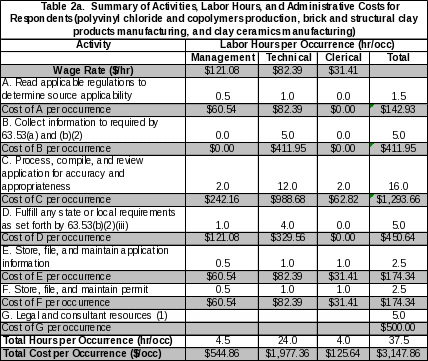 (1)
These are external consultations, assumed to be billed at $100/hr.
(1)
These are external consultations, assumed to be billed at $100/hr.
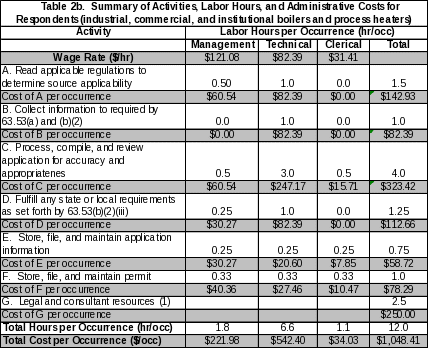 (1)
These are external consultations, assumed to be billed at $100/hr.
(1)
These are external consultations, assumed to be billed at $100/hr.
 (a)
EPA only review 10% of permit applications.
(a)
EPA only review 10% of permit applications.
(a) Number of Respondents consists of all existing sources and State and local agencies affected by the section 112(j) program
| File Type | application/msword |
| File Title | PART A OF THE SUPPORTING STATEMENT |
| Author | rcolyer |
| Last Modified By | Courtney Kerwin |
| File Modified | 2009-11-10 |
| File Created | 2009-09-29 |
© 2025 OMB.report | Privacy Policy
